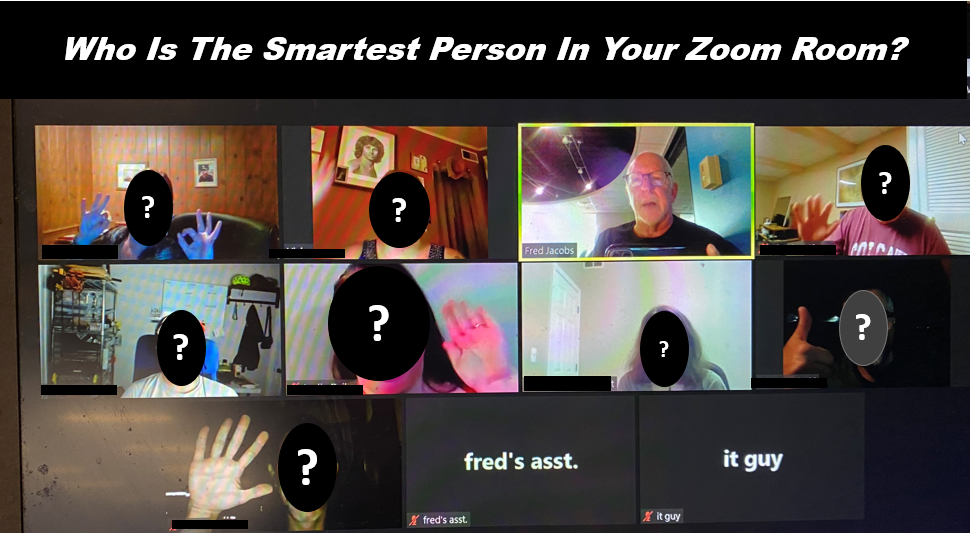
In recent weeks, this blog has focused on the need for more innovation, brainstorming, and creativity in broadcast radio. As the competitive waters get more crowded, radio broadcasters will need better content in order to compete on a broader scale. It’s not a budget issue – it’s about ideas, and where they will come from.
Today’s “Throwback Thursday” approach addresses this need head-on. It is nearly five years-old, but provides a road map for bringing out the best in your people, whether you’re meeting in the conference room or on Zoom. I’m fortunate to have worked with some great creative thinkers, but those “idea germs” most often come from these bigger rooms where at first, it’s about quantity rather than quality.
You’ll note my first suggestion is to stock the room with diverse people. In the years since this post was first published, many public radio organizations have adopted DEI initiatives – Diversity, Equity, and Inclusion – that are already showing signs of progress in the workplace.
They also are the pathways to better ideas. – FJ
June 2017
The smartest person in the room is…
…the room.
Wise words from the global chairman of Dentons, Joe Andrew. Dentons is a global law firm, and Andrew is a former political campaign manager – a guy who knows how to build consensus.
As he explained in last Sunday’s “Corner Office” feature in The New York Times, even the best and the brightest need to respect the collective brain power of the entire room.
And as Andrew tells it, that means ensuring that everyone around the table (or the Zoom room ) is comfortable sharing their thoughts, ideas, and strategies. There are “creativity killers” in every conference room brainstorm – often people who are exceptionally bright or who have a lifetime of achievement on their resumes. There are also the folks who are most resistant to change or have that tendency to shy away from a creative idea.
A lot of what he espoused in The Times matches up with what I often see around the board room table as well. Even well-populated rooms can be stifled by the bloviating from a couple of influential and loud people. And then there’s always that sense of defensiveness – especially when we’re in a radio meeting – and even fear, driven by resistance to change.
I think of some of the most creative things I’ve ever heard in radio, and most of them would have died a quick death in typical radio station conference rooms. What CEO or programming exec would have green-lighted any of the following ideas?
- Throwing the format out around Thanksgiving and going all-Christmas music for six weeks.
- Letting a couple of wise-cracking Boston mechanics talk about cars – and life – every Saturday morning.
- Allowing an insecure, gangly guy named Howard to do morning drive without the canned applause, character voices, or benchmark bits.
- Creating a 24-hour station that did nothing but talk about sports.
- Putting a card-carrying AARP member/therapist with a heavy accent on the radio on Sunday nights to talk about sex.
 I wish it was a longer list. I wish there were more recent examples of true out-of-the-box “holy crap” radio ideas. And I wonder what was the last amazing idea to come out of a radio conference room in the past 10 years – not coincidentally, the “PPM era.”
I wish it was a longer list. I wish there were more recent examples of true out-of-the-box “holy crap” radio ideas. And I wonder what was the last amazing idea to come out of a radio conference room in the past 10 years – not coincidentally, the “PPM era.”
For radio to once again become part of the cultural conversation, it will require rooms full of smart, inquisitive, and curious people coming together to truly conjure up new and innovative concepts during these turbulent times. And doing it in an atmosphere without limitations and conditions.
I’m convinced that none of these breakthrough radio ideas of the past would have seen the light of day in most modern-day meetings, and that’s why Andrew’s admonition that “the rules of the game is that you’re going to listen to others” is a good starting point.
But it goes beyond basic brainstorming – something that most of us in radio know how to do. It requires more than colored dots and big sheets of paper to truly innovate and break through.
In today’s business climate, the idea is to create the best environment in that big room. Here are some ideas about where to start:
- Recruit a diverse group – Not just the usual suspects and perhaps people from outside the industry (remember that everyone in the organization wants to contribute)
- Make everyone feel comfortable expressing ideas – That’s the key to generating new ideas
- Stress the value of creativity in the process – It’s unacceptable to walk out of the room with the same old stuff
- Don’t let anyone close down conversations – The worst thing that can happen
- Ask the tough questions and challenge yourself – And challenge everyone else
- Don’t be afraid to fail – It’s a requisite part of the innovation process
- Remember “Car Talk” and “Dr. Ruth” – Good examples of “bad ideas”
- Keep the food coming – Everyone needs to well-fed and hydrated

I’m in a lot of these meetings – often with charts and graphs, but also with the collective brainpower of a lot of bright people. They don’t always produce great results, but when they do, it’s a thing of beauty. It’s especially exciting to discover “a star” in the room – someone who others may have overlooked or under-estimated but who ends up contributing in a meaningful way.
The hope is that by adopting some of these guidelines, we can bring fresh concepts to light, foster a sense of collaboration and innovation, and spur more creative thinking.
It starts with respecting the power of the room.
- Media And Technology In 2025: Believe It Or Not! - April 18, 2025
- In Radio, You Just Never Know - April 17, 2025
- The Secret To Making A Great Podcast (And Great Radio) - April 16, 2025





Great stuff, Fred…
More of these kinds of true Brianstorming gatherings will be where the next BIG ideas come from!
Appreciate it, Bill.